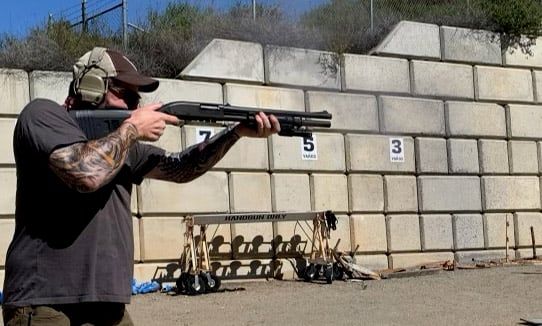
In light of a recent conversation on shotgun vs. AR-15 online at Defensive Foundations, we reached out to Steve “Yeti” Fisher to learn more about the benefits of a shotgun for home defense, why you might consider one over an AR, and why training and familiarity are what matters above all.
Q: Steve, we saw your comment on a Defensive Foundations post on Facebook, and it inspired us to do this article on the shotgun vs. AR-15. You made a very definitive statement in your comment on that thread, and my hope is that you could expand on your comment, as I know you are somewhat uniquely experienced with both the shotgun and the AR in a defensive role.
Steve “Yeti” Fisher – I’ve seen a few posts lately debating shotgun vs. AR-15, primarily from a defensive standpoint, and the usual suspects chimed in. Recently, one of these conversations took place on Matt Landfair’s (Primary & Secondary) Defensive Foundations group on Facebook.
In many online debates about shotgun vs. AR-15, you’ll see one group tout the idea of “Carbine, carbine, carbine. “Carbines are better because they have a greater capacity, they are lighter recoiling, and shotguns are old-fashioned etc.”
The reality is that both guns, the M4 carbine and variants, and the semi-auto & pump shotguns each have a place. I think a lot of the debate comes from those who may not have had a lot of experience with shotguns over their lifetime. Perhaps they have spent the last 20 years fighting the Great War on Terror, and the AR is all they’ve known. Maybe they only saw a shotgun used for breaching or the security guys using them. On the other end of the spectrum, you’ve got those who have had shotguns around them their entire life, and it’s simply the gun they would naturally grab should a home defense need arise.
In too many debates online, you see comments from those who either don’t understand the shotgun and/or are also not factoring in unknowns. Look, the AR is a great gun. I love them to death, and I teach on them and train with them. I use them for everything. That said, I also grew up with a shotgun in my hand, hunting. From the time I was ten years old, I had a shotgun. I hope that more people understand the why’s of shotgun vs. AR-15 and why both are usable, viable options for home defense.
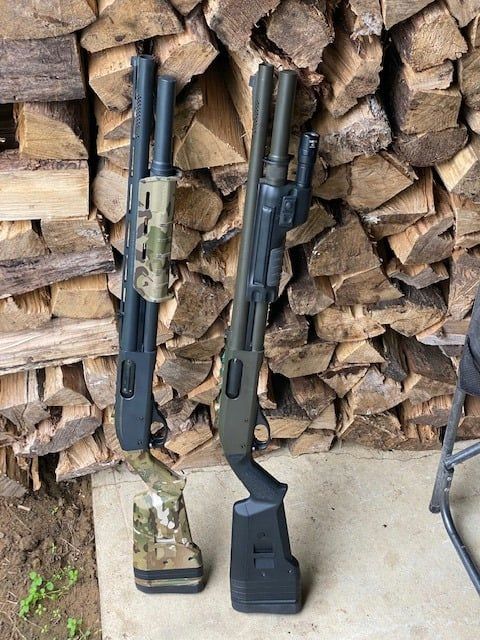
Q: For readers who may not be familiar with your shotgun background, can you explain some of the training you offer for shotguns?
Steve “Yeti” Fisher – As an instructor, I do teach shotgun courses. A few in the industry still do shotgun training very well. I currently offer two courses in it. One is a Practical Shotgun course, and the other is a Critical Shotgun course. The Practical Shotgun is for a new shotgun owner or someone who has had one stuffed in the closet or the corner of the house. It’s a one-day course that dispels a lot of myths. It covers patterning the gun, types of buckshot to use, accessories for the gun, managing recoil, loading the shotgun, getting comfortable, and just an overall familiarization with the manipulation of the gun and how to use it practically. It’s an excellent baseline class like you would take for almost any type of gun.
Critical Shotgun is an expansion where we start talking about things like alternative ammunition – slugs vs. buckshot, distance capability, shooting on the move, and position work.

Q: So, let’s get into the basics…make a case for the shotgun for home defense.
Steve “Yeti” Fisher – One thing to note with the shotgun is it’s generally considered to be a 50-state legal gun. So if you have a pump-action or double-barreled shotgun, you have a 50-state legal firearm, unlike a decked-out M4.
From there, shotguns can be very versatile with a simple ammunition or barrel change. This has been talked about for years, but the fact is that you can go from a hunting or sporting gun to a defensive gun very quickly.
Cost is another significant factor. You can get into a shotgun of reasonably good quality relatively inexpensively. If I am a new gun owner in just the past two or three years and want a home defense gun or perhaps a basic cabin gun for $250 to 400 dollars, I can get a very capable gun in my hands. For some, this cost is an important deciding factor versus the alternative of buying, at baseline, a $700-800 dollar carbine. Shotgun ammunition is also cheap still versus the cost of practice and defensive ammo for a carbine.
As to capabilities, the capabilities of a shotgun are absolutely devastating. One thing I always see in the debate of shotgun vs. AR-15 is capacity. In a standard M4, let’s say that 30 rounds is standard, and we have 30 55- or 62-grain projectiles coming out of the gun. That’s fantastic.
However, when you compare the energy of the shotgun vs. AR-15 and the capacity, things get interesting. The shotgun holds 6 or 7 rounds. The shotgun, per shell, holds anywhere from 8 to 24 pellets. With every press of the trigger, I could potentially be unloading half the magazine’s capacity with some of those loads.
In terms of energy, a single modern home defense/duty projectile coming out of a carbine has around 1,200-1,300 foot-pounds of energy. That projectile weighs basically the same as a single pellet in an eight or nine pellet load of buckshot coming out of a shotgun shell. With the mass of those combined eight or nine pellets, we’re dumping somewhere in the world of 1,600-foot-pounds of energy – around 400 more foot-pounds of energy than the carbine projectile.
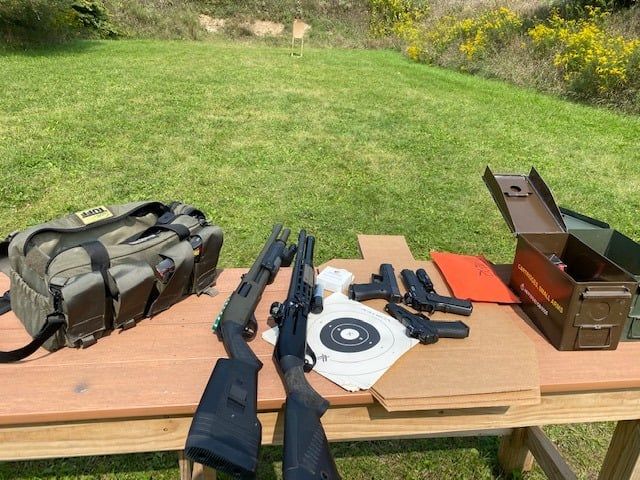
Q: The capacity argument is often made when discussing shotgun vs. AR-15. What’s your take on that?
Steve “Yeti” Fisher – Addressing the argument about capacity…you have to remember that what we are talking about is something taking place inside your house. According to crime statistics, most home invasions are 1.5 people causing that issue. How they came up with that .5 or half, I don’t know, (laughs), so I’ll call it one to two…Of course, there are situations where you’ll see five or ten, but that’s very uncommon.
Hearing about situations with this many intruders will cause many to make a case for the increased capacity. However, I believe that with one to two presses of a shotgun’s trigger, actions have begun to occur within the home. Actions have been imposed; they are probably going to leave. They are going to run. Yes, there is also the possibility of them shooting back, but in that case, ultimately having another six or seven rounds of definitive fight-stopping power with a shotgun, in my experience, is a great thing.
Following this thought process, most of my house guns today are shotguns. Yes, I still have a carbine available, as I live in a rural area. That said, are you going to be justified shooting outside of your house, across the street? Probably not.
Where the shotgun works really well – because of its pattern, pattern density, and spread – is shooting on the move, shooting on the move at things that are moving, and shooting on the move in low light at things that are moving. I also find a shotgun gives a better percentage of hits under stress for many people who are not overly well-trained with the gun.
It really comes down to knowing the gun, understanding patterns, pattern density, the load selection available to you. I’ve been teaching shotgun for the past twenty years, and I’ve always made it a habit to ask what the average distance of the average shot inside a house will be. The numbers I’ve heard repeatedly in my polls are between seven and ten yards. At that distance, with most shotguns, you’re going to end up with a spread of about 5″ with most quality buckshot, unless you were using Flite Control.
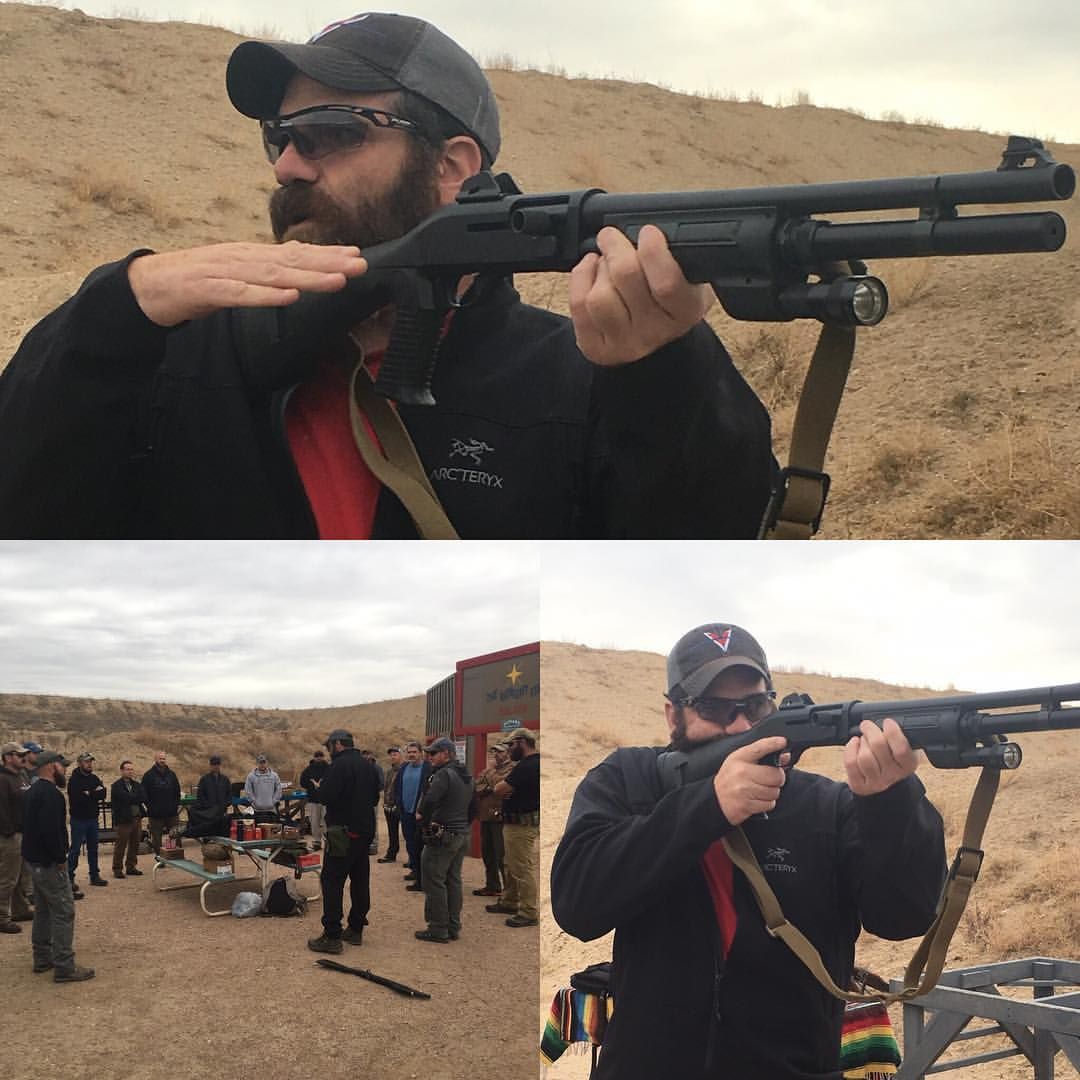
Q: I’ve heard a lot about Flite Control ammunition for the shotgun in recent times. Can you talk a bit more about it?
Steve “Yeti” Fisher – Ammo selection is essential with any firearm you choose to use. For a carbine, you want to use some sort of duty/defensive ammo, just like you would with your handgun. With a shotgun, you have multiple choices with buckshot loads. You want to find and use a load that patterns well in your gun to the maximum distance you will be using that gun.
You’ll hear the name “Federal Flite Control” thrown around an awful lot. It is a great load, and I shoot a lot of it. It shoots a very tight pattern. Inside of 10-15 yards, that round buckshot literally prints anywhere from a bore size diameter hole back to about a 2.5-3″ inch pattern at the far end of that range. It’s a very tight pattern, and it mitigates the chance of a missed shot or a flier. However, it requires a little bit more precision in your aiming.
Flite Control was originally designed for law enforcement to extend the usable distance of their shotguns. Back in the day, it was “after 15 yards, standard buckshot often blows its patten and has too big of a spread,” so you’d switch to a slug, which was more precise, and you could shoot out to 50 or 100 yards. Making that switch to a different type of ammunition took time. To help with this problem, Federal came up with Flite Control, a load that allowed the pattern to remain tight at almost double the distance.
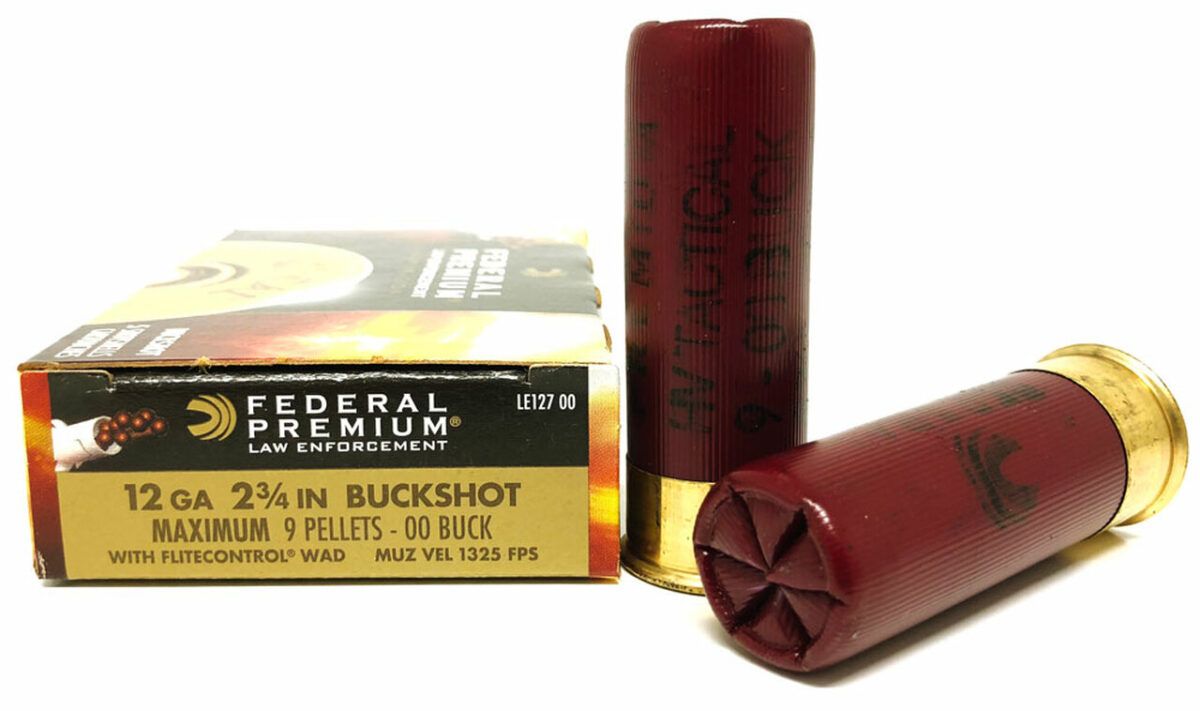
People are often amazed when they see the tight patterns of Flite Control, and again, it is a great load. However, I feel that sometimes it is too tight for the average house gun. I like a little bit more pattern, more spread of that shot group to give me a broader area of coverage. When I look for a 00-buckshot load, I want a pattern that gives me a closed fist-sized or open hand-sized pattern in the center of a USPSA or B8 target at a distance of about 10 yards.
If the load does that for you, you’ve found a good load. You don’t need to go out and find the most expensive load out there, like Flite Control, which is upwards of ten dollars for a box of five rounds. Due to the ammo availability crisis, Flite Control has also been hard to find and basically non-existent. We’re seeing people come back to standard, old, whatever buckshot they can find.
Now, because most normal 00-buckshot may or may not be buffered or have special wad cups to contain the shot to keep the pattern together longer, you might need to try four or five different types of ammunition to find a pattern you are happy with in your gun.
In finding those loads – from S&B, Fiocchi, Winchester, or Remington – again, people need to make sure they go out and pattern those loads. That also means shooting more than one round, as it can be inconsistent from round to round. You may need to shoot five of them to determine if you have a good pattern, pattern overlay, or density.
Q: Speaking of shotgun ammunition, what about potential over-penetration issues with a shotgun vs. AR-15?
Steve “Yeti” Fisher – As far as penetration, most of the 00-buckshot loads out there will penetrate slightly more than a carbine by about 4-inches on bare ballistic gelatin. There’s a case for this getting through intermediate barriers like heavy layers of clothing, bigger, denser-bodied people.
Now with anything, there is always the case of overpenetration of a miss. While a carbine will dump a lot of the energy exponentially as it goes through drywall and other household objects, that does not mean we should immediately dismiss the shotgun. We just need to know the pattern, the zero, and we need to practice and be proficient enough to lessen the chances of those misses.
Q: Size and weight wise, in your opinion, does one have an advantage over another in a home defense situation?
Steve “Yeti” Fisher – People will bring up the size of a shotgun in relation to a carbine. Let’s stick with the 16″ guns. We won’t get into SBR, AR pistols etc. These can be great for smaller frame shooters due to their size and balance point; they will often suffer when it comes to ballistics with the shorter barrels and improper loads as far as terminal performance goes.
Looking at a 16″ carbine, you’re looking at 35-36″ with the stock extended. Stock collapsed, you’re at 30-31″, if I recall correctly. An average shotgun is going to be around 36″ -39″ inches. So, we’re in the same area.
As far weight, when you consider what an M4 weighs with a loaded 30-round magazine and an optic, you’re looking at 7.5 to 8 pounds on average. A shotgun with a light attached will weigh about the same amount.
Keep in mind, you are not taking a shotgun and doing multiple mile movement with it. Rather, it’s a gun you’ll likely be barricading into a fixed position with. If you are moving with it, you’re probably moving less than five yards to get kids from one room to another or something similar.
Q: Let’s discuss recoil. Some might argue that it’s a significant reason to select an AR over a shotgun.
Steve “Yeti” Fisher – Recoil can be a deciding factor, no doubt about it. While a 12-gauge shotgun certainly recoils, there are means to mitigate that recoil through practice and training. For instance, there are specific techniques brought forth by Rob Haught years ago, like the Push/Pull technique.
It’s a way to mitigate the recoil of a shotgun to a manageable level, even with the heaviest buckshot loads or slugs. We also have a new crop of low-recoil buckshot that helps manage recoil. Vang Comp Systems, with their barrel porting, is yet another way to mitigate recoil.
We also now have very reliable, durable semi-auto shotguns. In conjunction with a good, low-recoil load, these shotguns can be a great combination and can make recoil very manageable for even the smallest frame shooters. I’ve seen this happen many times in my classes. Again, a little bit of training and practice can really go a long way.
Certainly, the carbine is more manageable, with lower recoil and faster follow-up shots for most people. That is a huge plus, but how often are you going to be shooting 20-30 rounds through that gun in rapid succession in a home defense scenario? I don’t know, but the cases, studies, and incidences I’ve seen, it never comes down to that. What I have seen with shotguns, though, is that they have decisively ended encounters with the first round fired.
I have never seen a shotgun shooting (data points, police reports, talking to the officers involved in the shootings) that have ever required – not saying there were not more rounds fired – but required more than one or two rounds fired. Most encounters we have seen have been ended with one to two shotgun rounds versus multiple rounds fired with carbines or handguns. There’s just no doubting a shotgun’s fight-stopping ability. Nobody can argue that.
Q: Any other information you think it’s important for readers to know as we wrap up the shotgun vs. AR-15 discussion?
Steve “Yeti” Fisher – Looking at the debate of Shotgun vs. AR-15, ultimately, I think it’s all a bit silly. The debate is senseless, yet it is very easy to get sucked into it because sometimes it is hard to tolerate some of the ignorance behind some of the comments you’ll see. (laughs).
Based on legalities, financial needs, and comfort zones, there are many great options for home defense. Pick the firearm that suits your needs, find a load for it, and move on. There is just nothing worth getting that spun up about one being better than the other when they all will work.
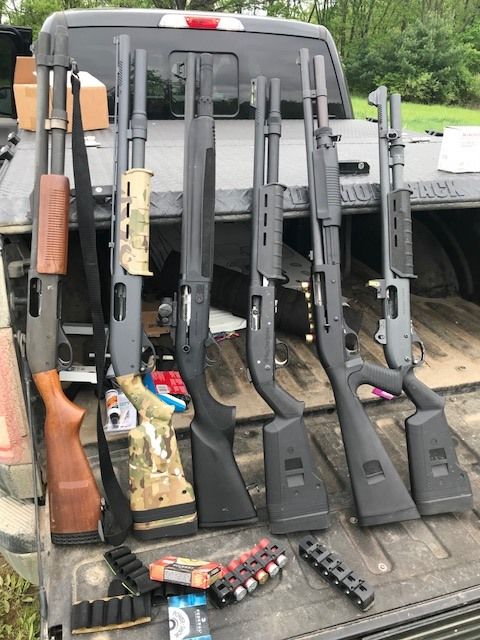
When it comes to shotgun vs. AR-15, use either or both. The bottom line is that you should choose what you are most comfortable with and what you have had the most training on. It’s not a debate over one being better than the other. . Choose what you have the most training on. Also, remember to choose wisely in regards to your ammo selection.
I can’t stress it enough – get some training, and I’m not saying that has to be from me, Rob Haught, or someone else for carbine and pistol work. You want to gain an understanding of whatever gun you choose. Get familiar with your selection and shoot it as often as you can, focusing on getting as comfortable as possible with the operation, manipulation, and recoil management.
###
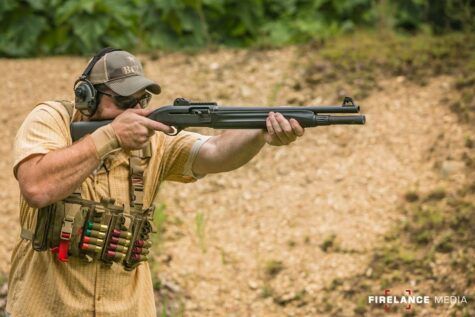
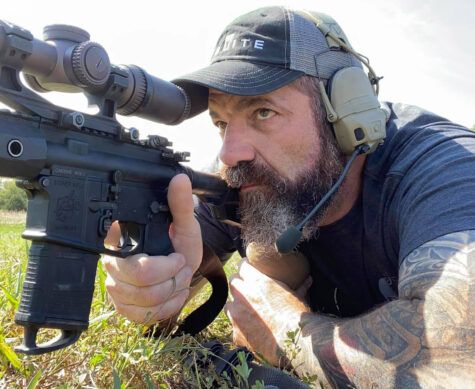
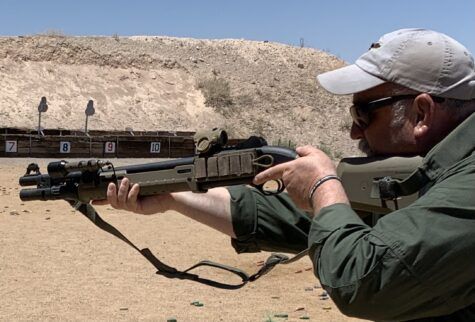


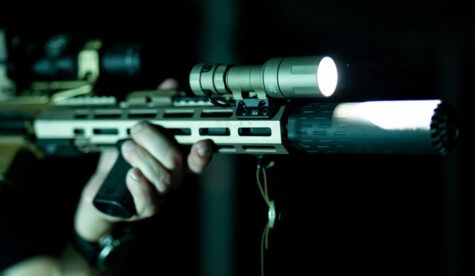
A nice compromise between many of the issues is to use a Mossberg shotgun with the insert that allows the 1 3/4” shells. They significantly increase capacity, the recoil is a fraction of a normal size 00 buck round, over penetration is significantly reduced and there have been multiple tests that show conclusively that it remains deadly inside of typical home invasion distances. A big plus for inexperienced types is the lack of recoil.
shotguns are a lot easier to “sell” to a DA in a home defense scenario than an AR, which is like honey to a leftist bee.
“…can make recoil very manageable for even the smallest frame shooters…”
Who told you that shooter size had anything to do with recoil tolerance? FAIL.